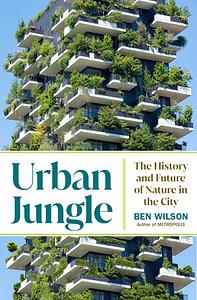Take a photo of a barcode or cover
informative
medium-paced
Nature good, cement and grass bad. A lot of useful information, but overly technical in some sections and tends to meander.
challenging
hopeful
informative
inspiring
medium-paced
challenging
informative
slow-paced
Really enjoyed the premise of this thoughtful book and enjoyed the references to the many places I’ve visited including the parks in London. Much of the book was pretty technical and didn’t hold my attention but the conclusion is especially great.
No number of trees, clean rivers and ecological parks will reverse the looming climate disaster. The concept of nature in the city has become increasingly important but more important is the question of the city in nature. A current day city needs to be able to react to unpredictable environmental shocks.
- more
Circular-
When cities ceased to be self-sufficient in terms of energy, fuel, food, water and raw materials they placed heavier burdens on the planet. The Dutch capital has an ambitious plan to reimagine capitalism in the 21st century. Striking a balance with nature, learning to live with water and flooding and functioning more like a natural ecosystem. At the heart of the problem is energy so Amsterdam will soon produce 80% of its energy with nearby solar arrays wind farms and biomass generators. Cadiz also owns its own power company. Cities possess greater power to control their flows of resources and implement large scale changes to their needs and that of the central government. Amsterdam wants to halve consumption of
Raw materials and become fully circular which requires recycling, reusing, repairing, and repurposing on large scale. Amsterdam is prioritizing the recycling of textile fibers into high quality clothing and by sponsoring repair services.
Cars take up 40% of public space- remove them!!!
And suddenly you have more rooms for hollyhocks and trees! Part of Amsterdams plan is to create a city for people, plants and trees. Car dependency wreaked havoc on cities. Weaning ourselves off of our private vehicle will not be easy.
Density is good for the environment too- when we stop spreading out we leave more land for nature. We also burn less gas: we walk, cycle, and take public transit more. We are weaving wildlife into urban fabric and are discovering urban ecosystems have a vital role to play in planetary health.
No number of trees, clean rivers and ecological parks will reverse the looming climate disaster. The concept of nature in the city has become increasingly important but more important is the question of the city in nature. A current day city needs to be able to react to unpredictable environmental shocks.
- more
Circular-
When cities ceased to be self-sufficient in terms of energy, fuel, food, water and raw materials they placed heavier burdens on the planet. The Dutch capital has an ambitious plan to reimagine capitalism in the 21st century. Striking a balance with nature, learning to live with water and flooding and functioning more like a natural ecosystem. At the heart of the problem is energy so Amsterdam will soon produce 80% of its energy with nearby solar arrays wind farms and biomass generators. Cadiz also owns its own power company. Cities possess greater power to control their flows of resources and implement large scale changes to their needs and that of the central government. Amsterdam wants to halve consumption of
Raw materials and become fully circular which requires recycling, reusing, repairing, and repurposing on large scale. Amsterdam is prioritizing the recycling of textile fibers into high quality clothing and by sponsoring repair services.
Cars take up 40% of public space- remove them!!!
And suddenly you have more rooms for hollyhocks and trees! Part of Amsterdams plan is to create a city for people, plants and trees. Car dependency wreaked havoc on cities. Weaning ourselves off of our private vehicle will not be easy.
Density is good for the environment too- when we stop spreading out we leave more land for nature. We also burn less gas: we walk, cycle, and take public transit more. We are weaving wildlife into urban fabric and are discovering urban ecosystems have a vital role to play in planetary health.
I think my favorite line was this, "Mud always wins. It's a question of when."
This is a critically important book. Wilson does an excellent job balancing the seriousness of the issue and pointing out the very real ways we can make change for the better. We need to see ourselves as part of the world. We need to build self-sufficient, cyclical systems and value what we have.
This is a critically important book. Wilson does an excellent job balancing the seriousness of the issue and pointing out the very real ways we can make change for the better. We need to see ourselves as part of the world. We need to build self-sufficient, cyclical systems and value what we have.
On the whole this was an interesting perspective on the relationship of nature and cities, and how the Industrial Revolution and colonialism in particular broke a lot of systems that were working (although I do think, and this wasn't directly addressed, given extant technology that if we'd stuck with these more sustainable approaches, this would've put a much stricter upper limit on the growth of cities until very recently. Of course if we had, we probably would've developed better and more relevant technology).
I did have one big problem with this book, which is that the author does not at any point acknowledge the difference between *introduced* and *invasive* species. (Credit where it's due: [b:The Aliens Among Us: How Invasive Species Are Transforming the Planet—and Ourselves|34746497|The Aliens Among Us How Invasive Species Are Transforming the Planet—and Ourselves|Leslie Anthony|https://i.gr-assets.com/images/S/compressed.photo.goodreads.com/books/1501898256l/34746497._SY75_.jpg|55938204][b:The Aliens Among Us: How Invasive Species Are Transforming the Planet—and Ourselves|34746497|The Aliens Among Us How Invasive Species Are Transforming the Planet—and Ourselves|Leslie Anthony|https://i.gr-assets.com/images/S/compressed.photo.goodreads.com/books/1501898256l/34746497._SY75_.jpg|55938204] is where I properly learned those terms.)
Like yeah, it's great to talk about how we have to work with what's around us rather than trying to recreate pre-Columbian landscapes--a process which itself is very fraught and causes all kinds of arguments in conservation spheres--but there's some particularly devastating invasive species where I live which are allelopathic, meaning they kill other plants in the area (and harm amphibians because their skin is so delicate), and on top of this, their berries are actually less nutritious than those of native plants', which then harms birds and such. (Buckthorn. I'm talking about buckthorn.)
On the opposite end there's species that, in this zone, aren't invasive because they aren't well-adapted to this particular climate (at least where it is right now); while these are technically safe to have around, non-prairie plants tend to have shallower roots which are not protective against flooding, so an introduced species needs to have a lot of the same qualities as a native one in order to be truly useful. Additionally, too much monoculture spreads disease--the emerald ash borer has been devastating in part because Chicago decided that ash should be *all* the shade trees--so the argument for biodiversity through natives, rather than whatever biodiversity you can get, isn't just a matter of snobbery or whatever.
So anyway, I did really like the history of cities, but I did find the discussion of the plant life/city biodiversity missing some crucial ingredients. He does mention that it's often constructed and not strictly "natural," but I didn't find enough of an exploration of the pros and cons there.
I did have one big problem with this book, which is that the author does not at any point acknowledge the difference between *introduced* and *invasive* species. (Credit where it's due: [b:The Aliens Among Us: How Invasive Species Are Transforming the Planet—and Ourselves|34746497|The Aliens Among Us How Invasive Species Are Transforming the Planet—and Ourselves|Leslie Anthony|https://i.gr-assets.com/images/S/compressed.photo.goodreads.com/books/1501898256l/34746497._SY75_.jpg|55938204][b:The Aliens Among Us: How Invasive Species Are Transforming the Planet—and Ourselves|34746497|The Aliens Among Us How Invasive Species Are Transforming the Planet—and Ourselves|Leslie Anthony|https://i.gr-assets.com/images/S/compressed.photo.goodreads.com/books/1501898256l/34746497._SY75_.jpg|55938204] is where I properly learned those terms.)
Like yeah, it's great to talk about how we have to work with what's around us rather than trying to recreate pre-Columbian landscapes--a process which itself is very fraught and causes all kinds of arguments in conservation spheres--but there's some particularly devastating invasive species where I live which are allelopathic, meaning they kill other plants in the area (and harm amphibians because their skin is so delicate), and on top of this, their berries are actually less nutritious than those of native plants', which then harms birds and such. (Buckthorn. I'm talking about buckthorn.)
On the opposite end there's species that, in this zone, aren't invasive because they aren't well-adapted to this particular climate (at least where it is right now); while these are technically safe to have around, non-prairie plants tend to have shallower roots which are not protective against flooding, so an introduced species needs to have a lot of the same qualities as a native one in order to be truly useful. Additionally, too much monoculture spreads disease--the emerald ash borer has been devastating in part because Chicago decided that ash should be *all* the shade trees--so the argument for biodiversity through natives, rather than whatever biodiversity you can get, isn't just a matter of snobbery or whatever.
So anyway, I did really like the history of cities, but I did find the discussion of the plant life/city biodiversity missing some crucial ingredients. He does mention that it's often constructed and not strictly "natural," but I didn't find enough of an exploration of the pros and cons there.
informative
medium-paced
With a better editing and organization, this could have been a 5-stars plus. Lots of great information but inconsistent development of ideas.
challenging
hopeful
informative
reflective
medium-paced
hopeful
informative
medium-paced


